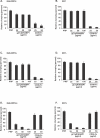Plasmodium falciparum uses gC1qR/HABP1/p32 as a receptor to bind to vascular endothelium and for platelet-mediated clumping
- PMID: 17907801
- PMCID: PMC2323294
- DOI: 10.1371/journal.ppat.0030130
Plasmodium falciparum uses gC1qR/HABP1/p32 as a receptor to bind to vascular endothelium and for platelet-mediated clumping
Abstract
The ability of Plasmodium falciparum-infected red blood cells (IRBCs) to bind to vascular endothelium, thus enabling sequestration in vital host organs, is an important pathogenic mechanism in malaria. Adhesion of P. falciparum IRBCs to platelets, which results in the formation of IRBC clumps, is another cytoadherence phenomenon that is associated with severe disease. Here, we have used in vitro cytoadherence assays to demonstrate, to our knowledge for the first time, that P. falciparum IRBCs use the 32-kDa human protein gC1qR/HABP1/p32 as a receptor to bind to human brain microvascular endothelial cells. In addition, we show that P. falciparum IRBCs can also bind to gC1qR/HABP1/p32 on platelets to form clumps. Our study has thus identified a novel host receptor that is used for both adhesion to vascular endothelium and platelet-mediated clumping. Given the association of adhesion to vascular endothelium and platelet-mediated clumping with severe disease, adhesion to gC1qR/HABP1/p32 by P. falciparum IRBCs may play an important role in malaria pathogenesis.
Conflict of interest statement
Figures





Similar articles
-
A simple protocol for platelet-mediated clumping of Plasmodium falciparum-infected erythrocytes in a resource poor setting.J Vis Exp. 2013 May 16;(75):e4316. doi: 10.3791/4316. J Vis Exp. 2013. PMID: 23711755 Free PMC article.
-
Association of severe malaria outcomes with platelet-mediated clumping and adhesion to a novel host receptor.PLoS One. 2011 Apr 29;6(4):e19422. doi: 10.1371/journal.pone.0019422. PLoS One. 2011. PMID: 21559373 Free PMC article.
-
Microvascular hemodynamics and in vivo evidence for the role of intercellular adhesion molecule-1 in the sequestration of infected red blood cells in a mouse model of lethal malaria.Am J Trop Med Hyg. 1998 Feb;58(2):240-7. doi: 10.4269/ajtmh.1998.58.240. Am J Trop Med Hyg. 1998. PMID: 9502610
-
Cytoadherence and sequestration in Plasmodium falciparum: defining the ties that bind.Microbes Infect. 2003 Aug;5(10):897-909. doi: 10.1016/s1286-4579(03)00162-x. Microbes Infect. 2003. PMID: 12919858 Review.
-
The molecular basis for the cytoadherence of Plasmodium falciparum-infected erythrocytes to endothelium.Semin Cell Biol. 1993 Oct;4(5):297-303. doi: 10.1006/scel.1993.1036. Semin Cell Biol. 1993. PMID: 8257782 Review.
Cited by
-
Malaria: modification of the red blood cell and consequences in the human host.Br J Haematol. 2011 Sep;154(6):670-9. doi: 10.1111/j.1365-2141.2011.08755.x. Epub 2011 May 28. Br J Haematol. 2011. PMID: 21623767 Free PMC article. Review.
-
Malaria Parasites: The Great Escape.Front Immunol. 2016 Nov 7;7:463. doi: 10.3389/fimmu.2016.00463. eCollection 2016. Front Immunol. 2016. PMID: 27872623 Free PMC article. Review.
-
PfEMP1 and var genes - Still of key importance in Plasmodium falciparum malaria pathogenesis and immunity.Adv Parasitol. 2024;125:53-103. doi: 10.1016/bs.apar.2024.02.001. Epub 2024 Mar 23. Adv Parasitol. 2024. PMID: 39095112 Free PMC article. Review.
-
A subset of group A-like var genes encodes the malaria parasite ligands for binding to human brain endothelial cells.Proc Natl Acad Sci U S A. 2012 Jun 26;109(26):E1772-81. doi: 10.1073/pnas.1120461109. Epub 2012 May 22. Proc Natl Acad Sci U S A. 2012. PMID: 22619330 Free PMC article.
-
Selection on cis-regulatory variation at B4galnt2 and its influence on von Willebrand factor in house mice.Mol Biol Evol. 2009 Mar;26(3):567-78. doi: 10.1093/molbev/msn284. Epub 2008 Dec 16. Mol Biol Evol. 2009. PMID: 19088380 Free PMC article.
References
Publication types
MeSH terms
Substances
Grants and funding
LinkOut - more resources
Full Text Sources
Other Literature Sources
Molecular Biology Databases
Research Materials
Miscellaneous

